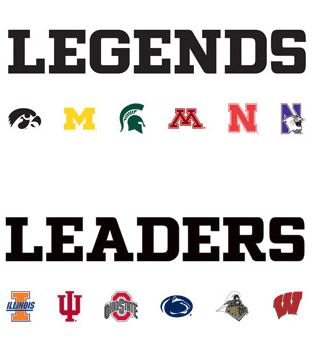BTN.com staff, December 12, 2012
With the Big Ten expanding to 14 teams, there is an open question as to whether basketball should go to divisions. Here's our take on it.
Josh: Now that the Big Ten is expanding to 14 teams, should basketball follow the lead of football and go with two divisions? Well, we can first look to a case study-the SEC. Up until this season, the SEC used a two-division format for basketball, splitting up the conference tournament by East and West. This season, the coaches voted to scrap that model, instead opting for seeding the teams based purely on conference record. The thinking was that by splitting up the tournament, good teams were suffering losses that hurt their tournament resume by virtue of playing in a ?sub-tournament? that featured less bad teams. Under the new format, bubble teams face marginally worse opponents in the opening round. But as Rush the Court has pointed out, not all wins are created equal. Quality wins matter to the committee, not wins over cupcakes.
But there is a real concern as the conference grows, and that?s one of fairness. With thirteen conference opponents for every team, we?d need a 26-game conference schedule to make things even. In an ideal world, teams would scrap cupcake games to make room, leaving the schedule to be loaded with conference games with room for a preseason tournament and 1-2 warmup games against low and mid-major teams. But that?s not going to happen.
 So it seems inevitable that conference play will result in unbalanced schedules. But with a split conference, we can mitigate this risk. Teams will play more games in their division, and less against other-division opponents. If the divisions are fairly balanced in terms of basketball quality, the result is going to be comparable schedules. Split up Indiana and Michigan State, two traditional basketball powers. Put Nebraska and Penn State on opposite sides, to prevent one division from loading up on wins against the basketball-weak schools. It won?t be perfect, but it?s better than leaving it a scrambled mess, where inevitably a handful of teams have a tremendous scheduling advantage.
So it seems inevitable that conference play will result in unbalanced schedules. But with a split conference, we can mitigate this risk. Teams will play more games in their division, and less against other-division opponents. If the divisions are fairly balanced in terms of basketball quality, the result is going to be comparable schedules. Split up Indiana and Michigan State, two traditional basketball powers. Put Nebraska and Penn State on opposite sides, to prevent one division from loading up on wins against the basketball-weak schools. It won?t be perfect, but it?s better than leaving it a scrambled mess, where inevitably a handful of teams have a tremendous scheduling advantage.
Of course, the problem is that the divisions are likely to carry over to the football side as well. Schools that are good at basketball are not necessarily good at football (Indiana, to take an example). But some schools are very good at both (Ohio State). Some schools aren?t very good at either (Minnesota, though the Gophers have had success in both sports, they?ve never been a consistent power in either one). But I?m confident there?s some arrangement that can be reached that can balance the two sports, and ensure a more fair scheduling.
Mike: Balanced scheduling is a valid concern, but I?d argue that splitting the conference into two divisions would defeat the original purpose. After all, isn?t the whole point to make sure the regular season champion is truly the best team, and not a pretender boosted by a lucky scheduling draw? If you split into divisions, you no longer even have a Big Ten champion-you have a Big Ten Leaders champion and a Big Ten Legends champion, and unlike football, there?s no guarantee that the two teams will meet in the postseason to settle the matter.
While postseason success is of paramount importance in college basketball, there?s still a certain prestige to winning the conference?s regular season. Michigan fans will likely recall the 2011-12 squad as ?Big Ten co-champions,? not ?NCAA second round participants,? and rightly so-postseason success can be fleeting and random for even the best teams. If the best possible regular season accomplishment becomes ?Big Ten Leaders Division champions,? the regular season loses a lot of luster.
Furthermore, if balanced scheduling is our main concern, I?d argue that better, more flexible approaches exist to tackle that problem. With an 18-game schedule and no divisions, each team would play everybody once, and then have five teams they?d play a second time. It?s not like we have no clue before the season which teams will be good and bad–objective preseason projections, based entirely on stats, are steadily improving. Here?s how the average of Dan Hanner?s and Ken Pomeroy?s preseason projections are playing out this season:
| Hanner preseason | KenPom preseason | Average preseason | KenPom now | Difference | |
| Indiana | 1 | 3 | 2 | 1 | 1 |
| Michigan State | 5 | 4 | 5 | 18 | -14 |
| Ohio State | 8 | 2 | 5 | 6 | -1 |
| Wisconsin | 33 | 6 | 20 | 11 | 9 |
| Minnesota | 23 | 26 | 25 | 9 | 16 |
| Michigan | 44 | 12 | 28 | 8 | 20 |
| Illinois | 54 | 54 | 54 | 33 | 21 |
| Purdue | 73 | 37 | 55 | 51 | 4 |
| Iowa | 64 | 53 | 59 | 55 | 4 |
| Penn State | 88 | 66 | 77 | 165 | -88 |
| Northwestern | 102 | 89 | 96 | 83 | 13 |
| Nebraska | 151 | 214 | 183 | 198 | -16 |
The column on the far right measures how accurate a simple average of these two preseason projections has been. We see that the preseason projections were fairly close on every team save Penn State, and that one is clearly off due to Tim Frazier?s injury. (Admittedly there?s some bias at work here, since KenPom?s preseason projections are still part of his current ratings, but I think the main point remains that we have solid projections readily available before every season.)
Armed with these preseason projections, a computer program could easily spit out a well-balanced schedule for a 14-team Big Ten, with home and away considerations included (after all, playing at Indiana is quite different from hosting Indiana). Sure, some teams would outperform their projection, and some teams would underperform, but on the whole you?d end up with each team facing an overall similar strength-of-schedule in conference play.
Divisions clearly could not promise that, as the split would be arbitrary. A glance at the 2010-11 SEC standings (and the huge discrepancy in Conference SOS across the divisions) shows how that can fail. Alabama won the SEC West at 12-4 and was (correctly) left out of the NCAA tournament due to a lack of quality wins. Still, that mediocre Alabama squad can forever tout that they were SEC West champions, illustrating how meaningless regular season hardware can become with divisions at work.
If we truly want the Big Ten?s regular season title to retain its value and legitimacy, objective and forward-looking scheduling is the path, not divisions.
***
Where do you stand on this conference realignment question and others? Take the survey below. BTN is using the feedback to drive debate on our TV shows and BTN.com posts all December.







 Check out what's coming up on B1G+ and subscribe to watch for more live events.
Check out what's coming up on B1G+ and subscribe to watch for more live events. 